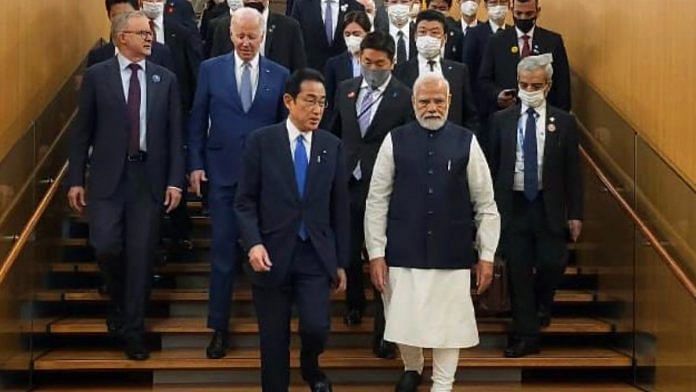The Biden administration must be alarmed by the recent decisions by several foreign corporations to either pull out of the Indian market or put their long-term plans on hold. The U.S. has, for years, hoped to assist India’s rise as a way of checking China’s growing power. But even though India is the world’s fastest growing major economy, its economic policies continue to disappoint American, European and Japanese officials and investors.
Western democracies, which see India as a natural ally, believe that India would be able to deliver on its economic and military potential only if it attains higher growth rates. That, in turn, would only be possible with larger inflows of foreign investment and further opening of India’s markets. Although India’s economy is expected to grow at 8 percent in 2022 and at 6.9 percent in 2023, it is less than the 12.5 percent and 8.5 percent originally forecast by the International Monetary Fund (IMF).
India’s growth is attributed to its large consumer market rather than to increased foreign direct investment (FDI). Indians seem content that India’s exports are high, its stock market is doing well and India’s vibrant middle class is indulging in what economists call post-pandemic “revenge spending.” But India’s Western partners see India as “a challenging place to do business,” according to the U.S. State Department’s 2021 Investment Climate Statement.
According to Heritage Foundation’s 2022 Index for Economic Freedom, India ranks 27 among 39 countries in the Asia–Pacific region, with an overall score below the regional and world averages.
From the perspective of the U.S. and India’s Western partners, it is a matter of unrealized expectations. India cannot catch up with China without overcoming the large gap in the relative size of their economies. China currently has a nominal GDP of $17.7 trillion while India’s GDP stands at only $3.1 trillion. On the other hand, India is expected to surpass China as the world’s most populous country in 2023, raising its domestic challenges of providing food, education and employment for an expanding young population.
Given its economic gap with China, and the needs of its growing population, it would seem reasonable that India would want to attract FDI. But between 2019 and 2021, the share of global FDI inflows to India have shrunk, from 3.4 percent to 2.8 percent. Meanwhile, China’s share of global FDI rose from 14.5 percent to 20.3 percent.
Even though the U.S., Europe, Australia and Japan all see India as their future partner, their corporations are either pulling out or reducing the size of their operations in India. Swiss building-materials firm Holcim, Royal Bank of Scotland, Harley-Davidson and Citibank have already announced plans to downsize or leave India.
German retailer Metro AG is selling off its Indian operation after two decades. Both Ford Motor Company and Tesla announced they had put on hold plans to make electric vehicles (EVs) in India. This decision, at a time when the Indian government is championing renewable energy, is related to India’s high tariff and tax barriers.
This week, French spirits group Pernod Ricard, maker of Chivas and Absolut, announced a decision to place new Indian investments on hold because of “everlasting” tax disputes with local authorities that date back almost 30 years.
Some $100 million in assets of Amway, the American multi-level marketing company that sells health, beauty and home care products, have been frozen by Indian law enforcement while the company is investigated for ostensibly “operating a pyramid scheme.” Ironically, the company has done business in India for three decades with the same business model of direct selling.
Moreover, Ricard is not the only international business facing taxation challenges in India. IBM has had $865 million stuck in an escrow account since 2009 while a tax dispute over retroactive tax meanders through India’s legal system. India could have used IBM’s nearly $1 billion if put to productive use.
Two U.K.-based companies – Telecom giant Vodafone and energy company Cairn –were hit with large capital gains tax demands based on legal changes after mergers or acquisitions. The Indian government took one decade to rollback its retroactive taxation policy, only after India lost two cases at the World Bank’s International Center for Settlement of Investment Disputes (ICSID) and The Hague tribunal.
The challenges notwithstanding, India’s large size and location continue to make it a prized market for foreign businesses. Air India, the formerly state-run airline now owned by Tata Group, announced plans to overhaul its entire fleet of 300 narrow-body jets in one of the largest orders in commercial aviation history. Boeing and Airbus are the leading contenders for this deal. Access to the large Indian consumer market is a dream, as is the hope for a stake in the upgradation of India’s civilian and military infrastructure.
But, by and large, Western hopes of a modern, fast-growing, prosperous and free market-oriented India have not been realized at the pace predicted by some in the first few years of the 21st century. India’s current rate of economic growth is woefully inadequate for India’s domestic goals as well as the objective of becoming a serious rival to global economic juggernaut, China. The latter makes India’s economic policies a strategic concern for U.S. policymakers.
Husain Haqqani is director for South and Central Asia at the Hudson Institute. He served as Pakistan’s ambassador to the U.S. from 2008 to 2011. Aparna Pande is director of Washington-based Hudson Institute’s Initiative on the Future of India and South Asia. Views are personal.
This article was first published by The Hill. You can read the original here.



